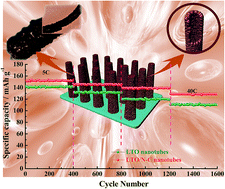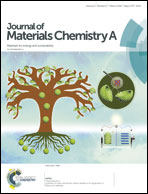Rational synthesis of Li4Ti5O12/N-C nanotube arrays as advanced high-rate electrodes for lithium-ion batteries†
Abstract
Tailored design/fabrication of high-rate electrodes is of great importance for construction of high-power lithium ion batteries (LIBs). In this work, we report a powerful strategy for fabrication of binder-free Li4Ti5O12/N-doped carbon (LTO/N-C) nanotube arrays via an atomic-layer-deposition (ALD)-lithiation plus chemical polymerization method. A thin N-C layer of 2–3 nm is homogeneously coated on the surface of LTO nanotubes of 400–450 nm forming high-quality LTO/N-C nanotube arrays with high electrical conductivity and large porosity. Due to the unique composite nanotube array architecture, the designed LTO/N-C nanotube arrays exhibit noticeable high-rate performance with a higher specific capacity (153 mA h g−1 at 5C), and better cycling performance (130 mA h g−1 at 40C after 1600 cycles) than the unmodified LTO nanotube arrays. The synergistic combination of the nanotube structure and N-C coating is favorable for fast ion/electron transfer, leading to reinforced high-rate Li ion storage. Our work reveals a new way for the synthesis of advanced electrodes for application in high-power LIBs.



 Please wait while we load your content...
Please wait while we load your content...